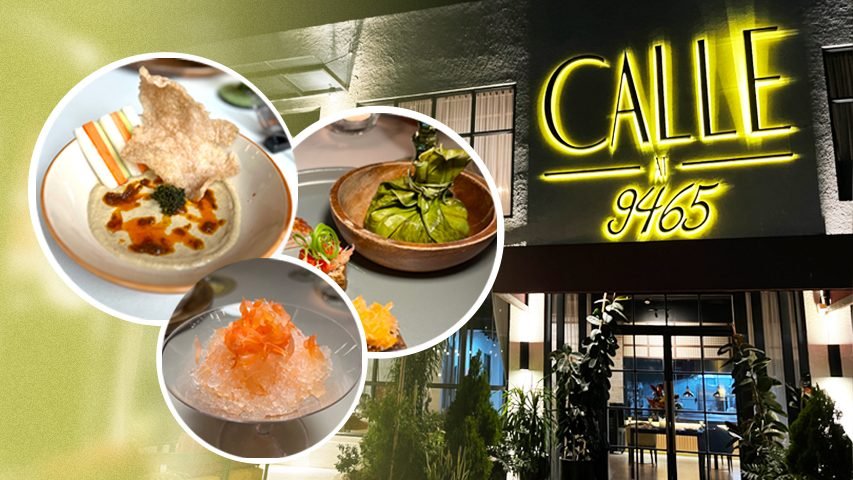MANILA, Philippines – Ever long for those carefree childhood beach trips with your family? Packing snacks, marinated meats, and ulam for the weekend, driving out to the province or your nearest out-of-town getaway, and then setting up camp under a kubo by the shore, laying out the banig, while your relatives fire up the grill for a feast of your favorite beachside staples.
This nostalgic memory is the common thread shared by the chefs of Calle at 9465, and it’s what inspired their newest summer tasting menu, Playa — a 12-course journey through Filipino beach outings of the ’90s, reimagined through expert culinary techniques that breathe new life into beloved native ingredients, with flavors that still feel familiar. Think creative spins on classics: aligue as a crisp tuile, vinaigrette made with bagoong, or salted egg ensalada transformed into a granita.

“Playa is a love letter to our childhood summers,” said Mark Lesan Quiray, owner and culinary director of Calle at 9465. “It draws from the food we grew up with — the beach trips, the meryenda moments — filtered through who we are now as a team and as a family in food.”
The kitchen at Calle is proudly collaborative. While it’s chef, Adrian Balanlayos, sous chef and head of R&D, who introduces the dishes tableside, chefs Noli Casim, Hazel Dalisay, Vlad Campomanes, and JM Donor are also at the shared helm — a synergy that’s felt in the cohesiveness of the menu.

“What makes Calle different is the shared energy in the kitchen,” Quiray shared. “Every dish is a product of collective input. It’s hard to say who made what — each plate reflects a group effort. That kind of collaboration leads to more refined, more resonant food.”
Calle at 9465, under the Qambra Food Corporation, is the Pampanga-rooted Quiray family’s biggest “leap of faith” to date. “It was born from a pandemic-era food tray concept (Calle Nakpil) and my mom’s lifelong love of food. After more than 10 years in catering and canteen operations, Calle at 9465 is our first step into the restaurant world,” Quiray said.

Launched in April, Playa’s concept is rooted in dishes reminiscent of family outings, fresh seafood, grilling by the beach, and the smoky, briny flavors that defined the season. It’s served across 12 courses, all for just P3,910++ — maybe the most value-for-money tasting menu in the metro, and easily one of the most filling.
Summer lovin’ that doesn’t break the bank
Offering 12 courses for under P4,000 seems almost suspicious — Calle’s portions are generous, and ingredients are of high quality. How does the Calle team pull it off?

“By keeping things seasonal and local,” Balanlayos told Rappler. Most ingredients are sourced “very locally” and just around the area, even the octopus. That way, prices remain low, and this affordability has become Calle’s fine dining edge.
Located in Parañaque City, Calle is quite literally a hidden gem. You’ll need to navigate a few side streets to find it, but once you do, the two-level space impresses in terms of size and rustic design.

It’s spacious, romantic, and inviting, with a bustling open kitchen and a beautiful cocktail bar that’s equal parts artsy and intimate both in the day and at night.

The meal opens with Kutkutin, a trio of familiar childhood snacks: Calle’s homemade take on shingaling made from polenta, a savory panutsa-style peanut brittle, and chicharon made from talakitok (jackfish) skin. They are meant to stay on your table the entire dinner — like beach baon you munch on the whole day between swims.

The salted fish skin with egg powder was a favorite — crispy and airy, with a dusting of umami. The peanut brittle gave just enough salty-sweetness to balance; however, the shingaling leaned on the harder side.
We then dive into the Rellenong Pusit — an ode to inihaw na stuffed pusit — a vibrant yet delicate dish of squid stuffed with jicama, red onion, and spring onion, on top of charred spring onion salad.

The clear sauce below is made from tomatoes fermented for two weeks and blended with salt, which brings out the tomato’s natural acidity and sweetness. It’s a bright palate opener: fruity, acidic, and slightly smoky, while the onions give it bite without being harsh.
One of my favorites of the night was the Inihaw na Talong, a creamy blend of roasted eggplant and in-house cashew butter (similar to babaganoush), topped with a bagoong vinaigrette, lato, jicama, carrots, and celery.

The inihaw na talong flavor is prominent and accentuated by that sharp bagoong vinaigrette that lends a salty tang. The dip’s creaminess and the fresh crunch of the vegetables balance each other out, while the lato on top adds that pop of salinity that instantly brings to mind the sea.
The vegan chicharon made from sago — cooked-down tapioca that’s dehydrated and fried — adds an inventive crunch.
The house-made Pancit Canton is Calle’s ode to the instant noodles found in every Filipino pantry. The version uses fresh egg noodles, meant to be mixed in with three sauces: garlic oil, chili oil, and a reduced shrimp stock — a play on the MSG-laden flavor packets we know so well.

While the octopus was tender and the noodles well-cooked, the dish leaned a bit too much on the sweet-savory side for me, somewhat like a yakisoba — I found myself looking for a bit more contrast or acidity to round it out, similar to the chilimansi flavor I typically go for.
We moved on to the Hindi Kinilaw, a play on the classic kinilaw minus the vinegar. Instead, cavalla is cured sashimi-style with salt, sugar, and ponkan zest, and served with a cucumber salad and a dressing made of cucumber trimmings, basil oil, and calamansi juice.

This was light, refreshing, and more citrus-forward, unlike your usual vinegar-heavy versions — the well-prepared fish was given its time to humbly shine.
For a sweet pause, the Binatog course is a nod to the beloved street snack, but here, it’s binatog two ways: the first, a stew cooked with clam juice and blended into something that reminded me of maja blanca meets clam chowder.

Underneath is whole binatog with muscovado sugar, topped with grilled clams (you’ll taste that smoky depth), toasted coconut, and coconut cream. It’s thick, warm, sweet, and slightly briny — like a comforting British soup but Filipino in flavor.
What’s a beach trip without green mango and bagoong? The Ensaladang Mangga is for my fellow salty-sour lovers out there. It features three kinds of tomatoes, pickled onion, hibe (small shrimp), and at the center: a salted egg granita, frozen and shaved into an umami-rich slush.

The dish is topped with a frozen green mango sorbet and a tuile made from shrimp. As a fan of green mango, this was a favorite — all the standard elements of the ensalada were there, but presented in ingenious ways. It was a punchy yet zesty dish that was sour, cold, crunchy, and savory — all in one bite.
A palate cleanser follows: Pom-Gin, a granita made of pomelo syrup, fresh pomelo, and house-fermented basil vinegar. You can opt to spike it with gin or not. Either way, it’s a zesty and fruity break that prepped us for the main courses.

Sugba is Calle’s tribute to tuna and its many grilled versions. In one plate, there’s sinugba, marinated in toyo, calamansi, and garlic (simple but stellar); sinuglaw, grilled and topped with vinegar, pomelo, and pickled red peppers; and Pinoy-style barbecue, glazed with sweet ketchup and garlic.

It’s tied together by gels made from toyomansi and pinakurat. On the side is the first rice of the evening — sticky rice cooked in coconut cream and pandan, wrapped in banana leaf, then steamed. It was a hearty and well-balanced dish that satisfied our itch for ulam and kanin, while highlighting the tuna’s versatility.
Sugpo leans into richness — Japanese rice sautéed in aligue, topped with atchara and an aligue tuile, then finished with a grilled shrimp skewer inspired by inasal.

The shrimp was plump and juicy, with just a touch of charred sweetness. While the rice was a bit harder than the sticky kanin na malagkit from the previous course — which took me by surprise — the overall flavor was simple yet satisfying. It reminded me of shrimp skewers done yakitori-style, but with Filipino seasoning at its core.
Sweet endings and final thoughts
“When you go to the beach, you can’t not have adobo,” Balanlayos said. “So, we made it into dessert.”
The menu closes with Adobo, the most inventive and memorable course for me: a bold dessert that features bay leaf ice cream served atop a soy sauce pavlova/meringue, with chantilly made from soy-cured egg yolks, a honey garlic glaze, cracked black peppercorns, and crispy garlic.

Sounds strange? Don’t knock it until you’ve tried it. It’s sweet and savory, creamy and crunchy — a layered, inventive take on adobo that works. You get just a whiff of the aromatic bay leaf, and the saltiness of the soy sauce and soy-cured egg yolks, uplifted by the punchy garlic and spiced up by the peppercorns.
It’s a genius dish that plays with memory, flavor, and form, without feeling gimmicky. That philosophy extends to their bar menu, too: the drinks are just as unique, like the savory-sweet Adobar mocktail.

Finally, the Matatamis ends the meal with warmth and nostalgia — a mix of suman with mango compote, frozen brazo de mercedes, sapin-sapin with layers of biko, puto calasiao, and tupig; and bitter cacao truffles striped with coco jam.

It’s meant to feel like the car ride home from the beach, with all the roadside sweets you picked up along the way, Balanlayos shared.
Calle sits along the balance of “easy” fine dining and casual, with chef-driven, creative dishes, but with flavors familiar to the Filipino palate. It doesn’t try to be overly elevated or gastronomical at the risk of being intimidating or unrecognizable. Instead, it celebrates pantry staples, local seafood, and garden-grown ingredients that feel like home, with each beautifully presented dish inspired by a specific Filipino memory.
The service is warm and quick, and the detailed explanations per course make you feel even more connected to the concept behind each dish. You know what you’re eating, why it’s there, and how it fits into Calle’s larger story.

It’s a dining experience I’d recommend to anyone, whether you’re new to tasting menus or someone who frequents Metro Manila’s fine dining scene. I left feeling full and more appreciative of our country’s rich gastronomy — that alone justifies the price you’re paying for the meal.
Available until the end of July, Playa doesn’t just feed you food but also serves you memory, flavor, and feeling, with thought, heart, and a love for Filipino culture evident in every plate. – Rappler.com
Calle at 9465 is located at 9465 Alejandro, Paranaque City, Metro Manila. It’s open from 11 am to 11 pm daily, except for Tuesdays. To book a table, you can do so on Instagram.











